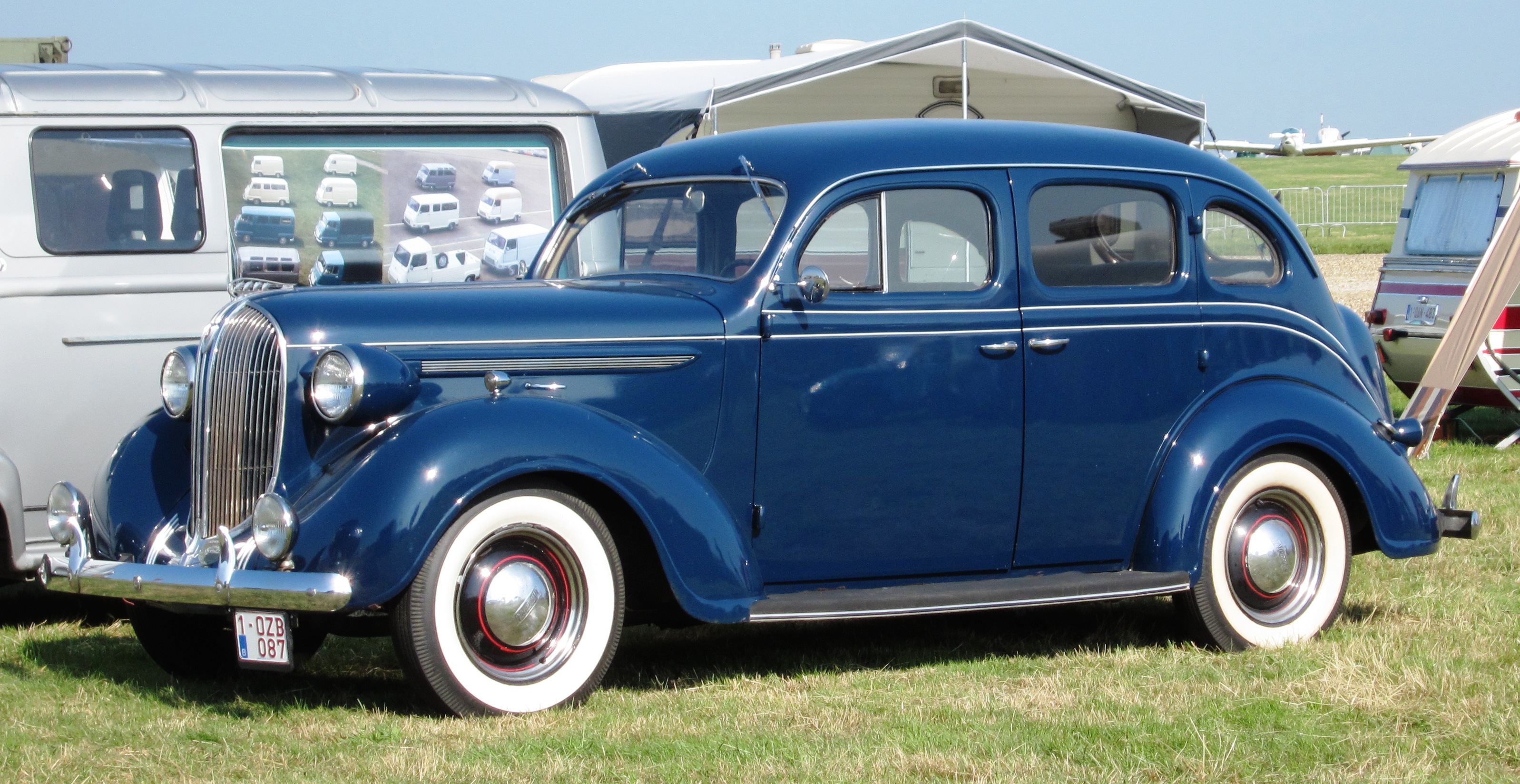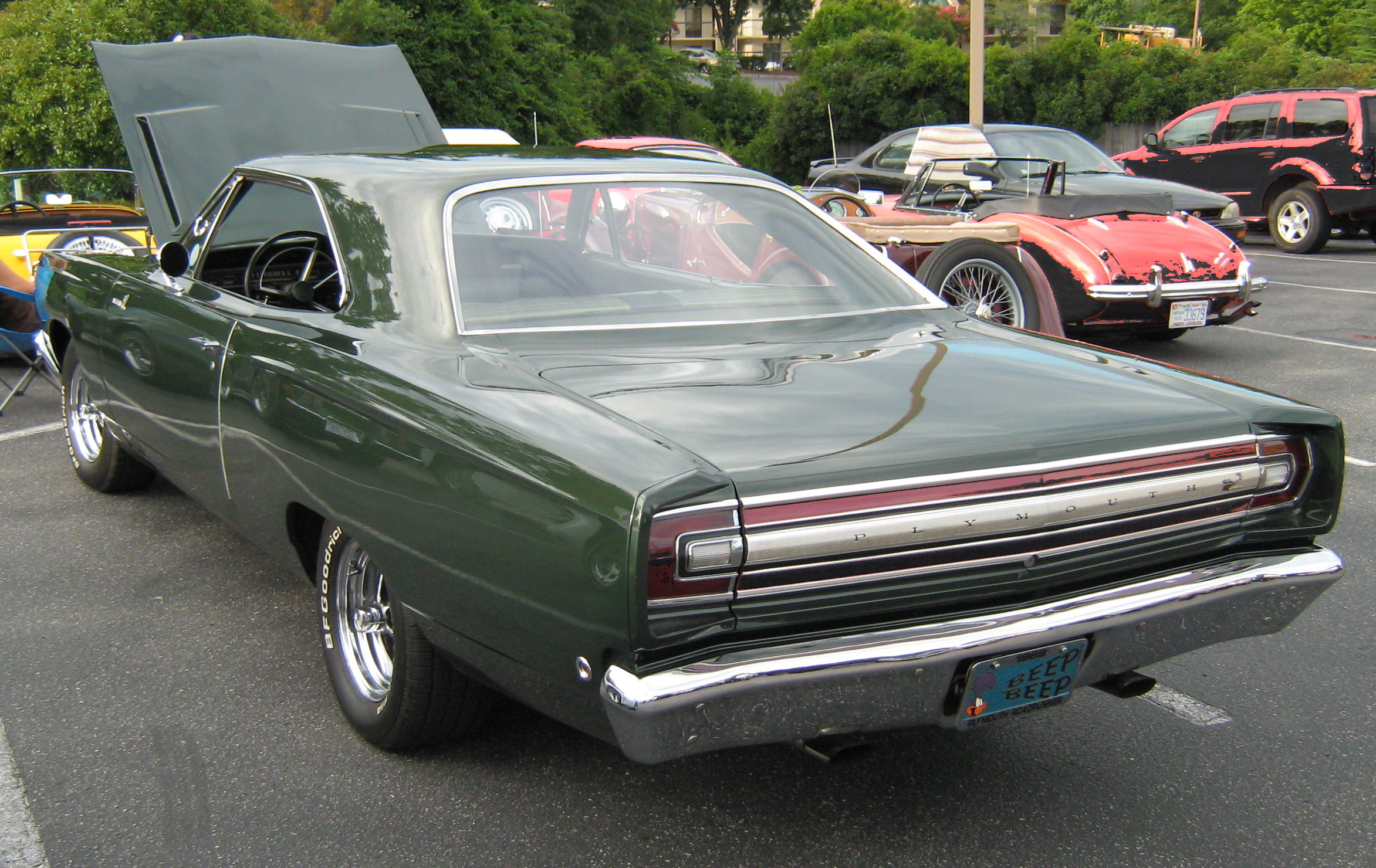|
Plymouth Satellite
The Plymouth Satellite is a mid-size automobile introduced in the 1965 model year as the top trim model in Plymouth's "B" platform Belvedere line. Available initially in two-door hardtop and convertible models, the Satellite remained the top-of-the-line model until the 1967 model year. A station wagon version was added and a higher "Sport" trim introduced. The Fury name was moved to Plymouth's mid-size models for 1975, at which time the Satellite name was discontinued. First generation (1965–1967) When the new Chrysler B Body platform was introduced in 1962 the Plymouth Belvedere name was moved from the full sized like to Plymouth's "new" mid-size line. Starting in 1965 the model line was split into the Belvedere I, Belvedere II, and the Belvedere Satellite which became the top trim model in the series, above the Belvedere I and II. It was available in two-door hardtop or convertible versions. Bucket seats and a center console were standard equipment, as well as a V8 e ... [...More Info...] [...Related Items...] OR: [Wikipedia] [Google] [Baidu] |
Plymouth Belvedere
The Plymouth Belvedere is a series of United States, American automobile models made by Plymouth (automobile), Plymouth from 1954 until 1970. The Belvedere name was first used for a new hardtop body style in the Plymouth Cranbrook line for the 1951 model year. In 1954, the Belvedere replaced the Cranbrook as the top trim and became a full model line with sedan (car), sedans, station wagons, and convertible body styles. The Belvedere continued as Plymouth's full-sized car until 1965 when it became an intermediate. It was replaced after the 1970 model year by the Plymouth Satellite, Satellite, a name originally used for the top-trim level Belvederes. The word "wikt:belvedere, belvedere" is Italian for "beautiful sight" or "fair view." Chrysler also had the Belvidere Assembly Plant in Belvidere, Illinois, which began vehicle production in 1965. However, the Plymouth Belvedere was never assembled there. During the 1950s and 1960s Chrysler Canada built the Belvedere for Commonwea ... [...More Info...] [...Related Items...] OR: [Wikipedia] [Google] [Baidu] |
Plymouth (automobile)
Plymouth was a brand of automobiles produced by Chrysler, Chrysler Corporation and its successor Mercedes-Benz Group, DaimlerChrysler. The brand was launched in 1928 to compete in what was then described as the "low-priced" market segment that was dominated by Chevrolet and Ford Motor Company, Ford. It became a high-volume seller for the automaker until the late 1990s. Plymouth cars were marketed primarily in the United States. The brand was withdrawn from the marketplace in 2001. The Plymouth models that were produced up until then were either discontinued or rebranded as Chrysler or Dodge. History Origins The Plymouth automobile was introduced at Madison Square Garden (1925), Madison Square Garden on July 7, 1928. It was Chrysler Corporation's first entry in the low-priced field previously dominated by Chevrolet and Ford. Plymouths were initially priced higher than the competition, but offered standard features such as internal expanding hydraulic brakes that Ford and Chevr ... [...More Info...] [...Related Items...] OR: [Wikipedia] [Google] [Baidu] |
Plymouth GTX
The Plymouth GTX is an automobile introduced as the Belvedere GTX in 1967 by the Plymouth division. It was positioned as a mid-sized upscale-trimmed performance muscle car through the 1971 model year. __TOC__ 1967 The GTX was based on the Belvedere, and was differentiated by a blacked out grille and special rear fascia, fiberglass simulated hood scoops with optional racing stripes, a chrome "pop-open" fuel filler cap, and a tachometer mounted on the center console. The GTX was positioned as a "gentleman's muscle car". Standard was Plymouth's V8 engine called the " Super Commando 440" rated at . Optional was Chrysler's Hemi. A heavy duty suspension system was also standard. Performance 1968-1970 1968 Chrysler introduced major changes in the design of the 1968 model Plymouth B-bodies and the GTX was given a completely new look. A new hourglass body replaced the previous rectilinear design. The high performance 440 was standard in the GTX as was the TorqueFlite automa ... [...More Info...] [...Related Items...] OR: [Wikipedia] [Google] [Baidu] |
Chrysler Slant-6 Engine
The Chrysler Slant-Six is the popular name for an overhead valve inline-6 engine produced by Chrysler Motors between 1959 and 2000. Featuring a reverse-flow cylinder head and cylinder bank inclined at a 30-degree angle from vertical, it was introduced in and displacements for the 1960 model year. It was a clean-sheet design known within Chrysler as the G-engine, built as a direct replacement for the flathead Chrysler straight six that the company started business with in 1925. The design proved very successful, being utilized in cars, trucks, boats, and agricultural, and industrial applications. Design The Chrysler Slant Six engine was a clean-sheet design, led by Willem Weertman, later Chrysler's chief engine designer. Its characteristic 30° inclined cylinder block gave it a lower height, copying the same cant Mercedes-Benz had introduced in 1952 in its M186-engined 300SL sports car. This enabled Chrysler stylists to lower hood lines, and also made room for the ... [...More Info...] [...Related Items...] OR: [Wikipedia] [Google] [Baidu] |
Plymouth Roadrunner
The Plymouth Road Runner is a muscle car introduced by Chrysler in the United States for the 1968 model year and marketed under its Plymouth (automobile), Plymouth brand. Initially based on the Plymouth_Belvedere#1968–1970, Belvedere, the brand's basic mid-size car, mid-size model, the Road Runner combined a powerful engine with a spartan trim level and a price that undercut increasingly upscale and expensive muscle cars such as the Pontiac GTO and Plymouth's own Plymouth GTX, GTX. It was initially a sales success. The Road Runner was built in three generations on the mid-size Chrysler B platform, B platform. Like most muscle cars, its performance and sales declined in the 1970s due to an increasing focus on fuel economy and the adoption of more stringent U.S. United States vehicle emission standards, emission standards. The nameplate became to a Automotive_trim_level#Options_packages, trim package for the compact car, compact Plymouth Volaré for model year 1976—no longer ... [...More Info...] [...Related Items...] OR: [Wikipedia] [Google] [Baidu] |
Station Wagon
A station wagon (American English, US, also wagon) or estate car (British English, UK, also estate) is an automotive Car body style, body-style variant of a Sedan (automobile), sedan with its roof extended rearward over a shared passenger/cargo volume with access at the back via a third or fifth door (the liftgate, or Trunk (automobile)#Tailgate, tailgate), instead of a trunk/boot lid. The body style transforms a standard Three-box styling, three-box design into a Three-box styling#One-box and Two-Box design, two-box design—to include an Pillar (car), A, B, and C-pillar, as well as a D-pillar. Station wagons can flexibly reconfigure their interior volume via fold-down rear seats to prioritize either passenger or cargo volume. The ''American Heritage Dictionary'' defines a station wagon as "an automobile with one or more rows of folding or removable seats behind the driver and no luggage compartment but an area behind the seats into which suitcases, parcels, etc., can be loaded ... [...More Info...] [...Related Items...] OR: [Wikipedia] [Google] [Baidu] |
Sedan (car)
A sedan (American English) or saloon (British English) is a automobile, passenger car in a three-box styling, three-box configuration with separate compartments for an engine, passengers, and cargo. The first recorded use of ''sedan'' in reference to an automobile body occurred in 1912. The name derives from the 17th-century Litter (vehicle), litter known as a sedan chair, a one-person enclosed box with windows and carried by porters. Variations of the sedan style include the close-coupled sedan, club sedan, convertible sedan, fastback sedan, hardtop sedan, notchback sedan, and sedanet. Definition A sedan () is a car with a closed body (i.e., a fixed metal roof) with the engine, passengers, and cargo in separate compartments. This broad definition does not differentiate sedans from various other car body styles. Still, in practice, the typical characteristics of sedans are: * a Pillar (car), B-pillar (between the front and rear windows) that supports the roof; * two rows of s ... [...More Info...] [...Related Items...] OR: [Wikipedia] [Google] [Baidu] |
Plymouth Road Runner
The Plymouth Road Runner is a muscle car introduced by Chrysler in the United States for the 1968 model year and marketed under its Plymouth brand. Initially based on the Belvedere, the brand's basic mid-size model, the Road Runner combined a powerful engine with a spartan trim level and a price that undercut increasingly upscale and expensive muscle cars such as the Pontiac GTO and Plymouth's own GTX. It was initially a sales success. The Road Runner was built in three generations on the mid-size B platform. Like most muscle cars, its performance and sales declined in the 1970s due to an increasing focus on fuel economy and the adoption of more stringent U.S. emission standards. The nameplate became to a trim package for the compact Plymouth Volaré for model year 1976—no longer offering any special performance capability—and was discontinued in 1980. Origin Plymouth paid $50,000 to Warner Bros.-Seven Arts to use the Road Runner name and likeness from their Wile E. ... [...More Info...] [...Related Items...] OR: [Wikipedia] [Google] [Baidu] |
Automatic Transmission
An automatic transmission (AT) or automatic gearbox is a multi-speed transmission (mechanics), transmission used in motor vehicles that does not require any input from the driver to change forward gears under normal driving conditions. The 1904 Sturtevant "horseless carriage gearbox" is often considered to be the first true automatic transmission. The first mass-produced automatic transmission is the General Motors ''Hydramatic'' two-speed hydraulic automatic, which was introduced in 1939. Automatic transmissions are especially prevalent in vehicular drivetrains, particularly those subject to intense mechanical acceleration and frequent idle/transient operating conditions; commonly commercial/passenger/utility vehicles, such as buses and waste collection vehicles. Prevalence Vehicles with internal combustion engines, unlike electric vehicles, require the engine to operate in a narrow range of rates of rotation, requiring a gearbox, operated manually or automatically, to drive t ... [...More Info...] [...Related Items...] OR: [Wikipedia] [Google] [Baidu] |
Manual Transmission
A manual transmission (MT), also known as manual gearbox, standard transmission (in Canadian English, Canada, British English, the United Kingdom and American English, the United States), or stick shift (in the United States), is a multi-speed motor vehicle Transmission (mechanical device), transmission system where gear changes require the driver to manually select the gears by operating a gear stick and clutch (which is usually a foot pedal for cars or a hand lever for motorcycles). Early automobiles used ''sliding-mesh'' manual transmissions with up to three forward gear ratios. Since the 1950s, ''constant-mesh'' manual transmissions have become increasingly commonplace, and the number of forward ratios has increased to 5-speed and 6-speed manual transmissions for current vehicles. The alternative to a manual transmission is an automatic transmission. Common types of automatic transmissions are the Automatic transmission#Hydraulic automatic transmissions, hydraulic automatic ... [...More Info...] [...Related Items...] OR: [Wikipedia] [Google] [Baidu] |
Chrysler Hemi Engine
The Chrysler Hemi engine, known by the trademark Hemi or HEMI, refers to a series of high-performance American overhead valve V8 engines built by Chrysler with hemispherical combustion chambers. Three generations have been produced: the FirePower series (with displacements from to ) from 1951 to 1958; a famed race and street engine from 1964-1971; and family of advanced Hemis (displacing between since 2003. Although Chrysler is most identified with the use of "Hemi" as a marketing term, many other auto manufacturers have incorporated similar cylinder head designs. The engine block and cylinder heads were cast and manufactured at Indianapolis Foundry. During the 1970s and 1980s, Chrysler also applied the term ''Hemi'' to their Australian-made Hemi-6 Engine, and a 4-cylinder Mitsubishi 2.6L engine installed in various North American market vehicles. Design The main advantage of a hemi head engine over other head designs is power. In return, hemi head engines tend to ... [...More Info...] [...Related Items...] OR: [Wikipedia] [Google] [Baidu] |









